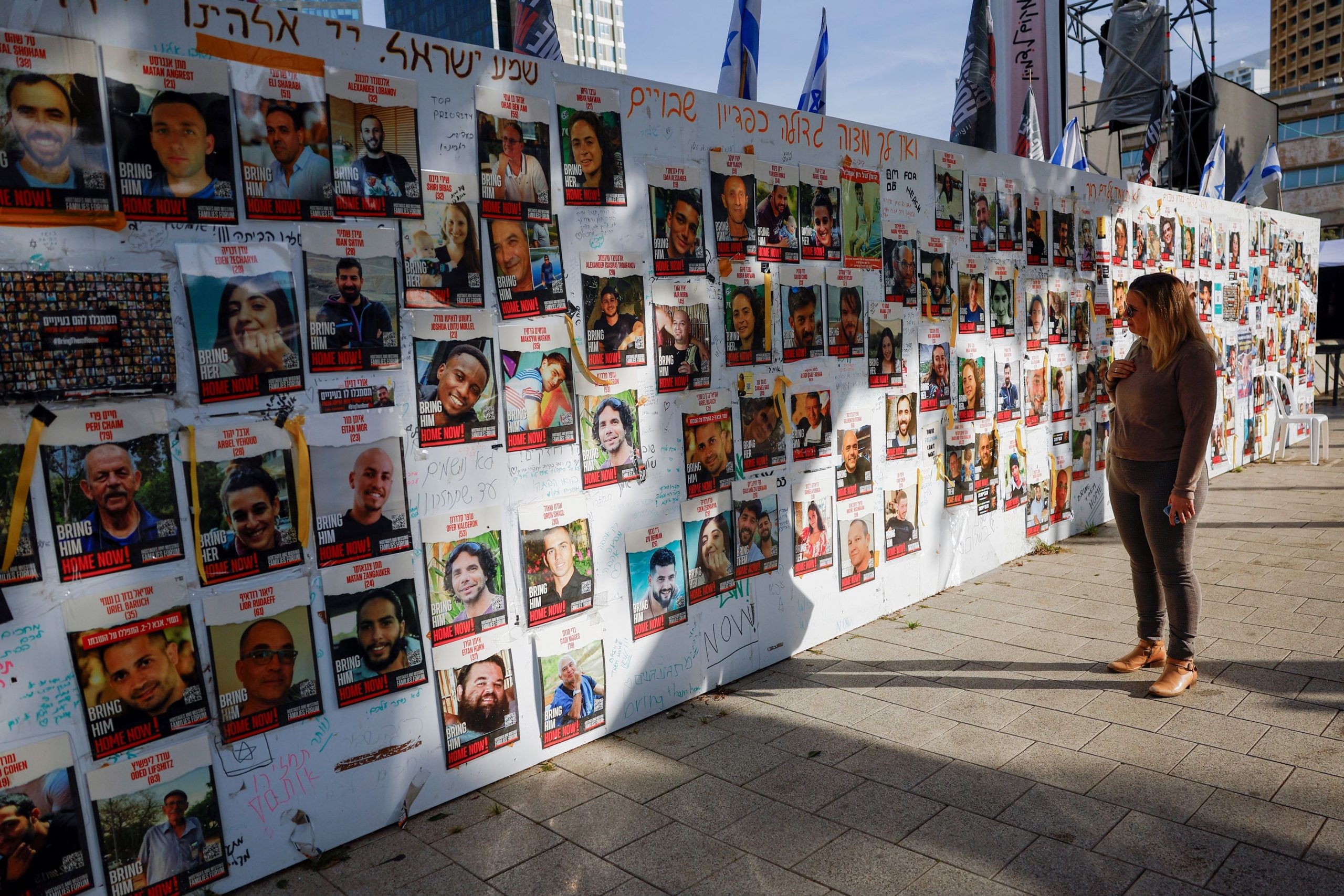Just days into captivity , Tamar Metzger felt her energy fading rapidly. She began to notice herself sometimes slipping into what felt like a state of half-consciousness. Slumped against a white ceramic-tile wall that was moist from humidity, she struggled to pace her breath.
Boredom set in. Her hearing felt weak. The voices of people near her seemed faint, including that of her husband, who was constantly bickering with a decades long friend about everything from history to film.
Tamar, 78 years old, found herself counting a ribbon of brown tiles on the opposite wall a few feet away. Their edges were darker brown and they ran in two horizontal layers. She found them oddly beautiful in a cell that had no furnishings except for the AstroTurf they laid their sleeping mats on and a fan that was constantly breaking down.
With her were about a dozen people from the Nir Oz kibbutz, including two Thai farmhands, an elderly Israeli historian, a cinema buff and an anxious father who didn’t know if his wife and children were alive.
They were hostages being held in an enormous tunnel complex built by Hamas under the south Gazan town of Khan Younis. It wasn’t clear to Tamar how many others were underground with them—Hamas took more than 250 people captive during its attack on Israel on Oct. 7 . At one point, when their room began shaking from Israeli airstrikes far above, their guards rushed all of them into a different space with another crowd of hostages for a few days.
Tamar, who was released after 53 days in captivity, described her day-to-day experience in hours of interviews with The Wall Street Journal. Right up until her handover to the Red Cross on Nov. 28, she was unsure if she would be able to return home, let alone what would happen to those held with her. Her husband and other men in the group remain captive.
She said many of her group hoped the Israeli government would strike a deal with Hamas to free everyone. They didn’t want a high-wire military attempt to free them that might result in deaths.
The retiree and avid reader was part of a group of women and children who were returned to Israel from Gaza in daily batches during a one-week cease-fire deal between Israel and Hamas in late November. The U.S.-designated terrorist group continues to hold more than 130 people.
This account of life in the tunnels is based on Tamar’s description as well as interviews with relatives of freed hostages and video testimonies by released hostages to Israeli media.
The Israeli government and international mediators are negotiating for the release of hostages, while Israeli soldiers and intelligence officers have painstakingly searched for them. Adding to the country’s collective anguish, the information about them has included propaganda videos from militant groups with unconfirmed statements—including one of hostage Yarden Bibas with Hamas saying his wife and two redheaded little boys, who had captivated hearts in Israel, had been killed in an Israeli airstrike.
In recent weeks, the Israeli military raided the Khan Younis underground complex, which it said was rigged with explosives and blast doors and likely cost hundreds of thousands of dollars to build. It found no hostages but said it saw evidence that about 20 hostages had been there at various times. The Journal verified footage and photos released by the military showing a passageway about a half mile in length winding more than 65 feet deep, with a kitchenette, bathrooms and cells.
Israel is now trying to forge a new deal to secure the remaining hostages. An initial U.S.-backed proposal that Egyptian and Qatari mediators relayed to Hamas outlines a six-week pause in fighting, during which civilian hostages, including children, the elderly and sick, would be released. The next two phases would have Hamas releasing female and male Israeli soldiers as well as the bodies of dead hostages.
A detailed counterproposal by Hamas this week showed that the two sides are still far from a deal , the Journal reported. Israeli Prime Minister Benjamin Netanyahu rejected the militant group’s demands, which included the mass release of Palestinian prisoners.
Relatives of hostages have tried to increase pressure on Netanyahu by protesting outside his Mediterranean seaside villa and apartment residence in Jerusalem, and by blocking a major expressway in Tel Aviv. Former hostages, many of whom have friends and family still being held, have also screamed at officials to get their loved ones back home instead of trying to dismantle Hamas first. A recent Israeli assessment said as many as 50 of the hostages could be dead , considerably higher than the 29 deaths Israel has publicly acknowledged, the Journal reported.
Discussing the Holocaust
Tamar was in shock when she was shoved into a vehicle with other hostages on Oct. 7 . Her face was bruised and blood ran down her legs from falling off a motorbike earlier. Suddenly she heard a female whisper next to her.
“Tammy, I’m with you. Don’t be afraid.” It was her friend Nili Margalit. Tamar had known the 41-year-old nurse since she was born on the kibbutz.
The women were dropped off at a tunnel shaft near a warehouse-style building. It was risky to talk much, let alone embrace each other. Their kidnappers, who wore civilian clothing, turned them over to Hamas men after what seemed like a period of bargaining.
As they descended underground, the muddy path was barely visible in the dark. Tamar was a longtime smoker and had asthma and high blood pressure. She held on to the back of Nili’s pants to keep up. She was barefoot—her slippers had fallen off earlier. They walked past rocks, boxes, sandbags and other construction material.
At some point, Tamar’s feet were so numb she couldn’t feel the ground. “Go, go, go,” their kidnappers kept saying.
As they moved through the tunnel, they got a glimpse of a large well-lit area with computers where Hamas men worked. Some later saw a prisonlike cell that an Israeli couple was kept in because the woman had raised her voice with another hostage.
They eventually arrived at a room where they saw about 20 hostages seated on the floor. They included Tamar’s husband, Yoram Metzger, who had been in a different part of their house when kidnappers broke in. Some of the people were wounded and bleeding. Hamas separated those with more serious injuries from the elderly of Nir Oz, taking the latter group to a holding area.
The space would become their underground home.
In a small space for cooking, Adina Moshe, a 72-year-old retired kindergarten teacher and Tamar and Nili’s friend, would heat up rice and canned green peas, even though she didn’t have her eyeglasses and couldn’t see well. The shelves were well-stocked, as if in preparation for a large crowd. Five or six of the hostages would gather around one plate, each with a spoon. After about two weeks, only rice was left.
They soon realized they needed a way to pass the time.
Alex Dancyg, a 75-year-old scholar at Yad Vashem, Israel’s main Holocaust memorial, began to give lectures about his studies. Alex had been born in Poland after the war, but his sister was a Holocaust survivor.
That history was painful to hear. Some in the group pleaded for him to change the subject.
Yoram, 80, quizzed the group on the Bible and popular culture. He knew Arabic so Hamas captors at one point took him to another room where they made him translate the news for them on Hebrew television. Yoram didn’t have his hearing aid so they had to blast the sound.
There was also Chaim Peri, an 80-year-old filmmaker who talked about the history of cinema, including the rise of Hollywood. Later, Hamas made him and Yoram appear in a propaganda video broadcast to the outside world titled “Do not cast me away when I’m old,” a line from Psalm 71.
But even with the three talkative men, the room often fell silent. People spent long stretches in their own head, especially Yarden, the father of the redheads. The 34-year-old had been kidnapped at a different location in the kibbutz from his wife and children, who had stayed in their home’s safe room. Tamar said Yarden felt guilty that he hadn’t stayed with them.
He had hoped Israeli soldiers had saved his family, but he grew distressed in the tunnels as he received no news. One day, the captors told him they had spotted his kids in Tel Aviv, just to get him to calm down.
Nili had asked the guards for tablets of clonazepam—an antianxiety medication—that she divided up among the hostages including Yarden to help them relax and sleep. One male hostage suffered from nightmares and wouldn’t stop hitting his friend during sleep.
Not knowing whether it was day or night made things worse. When the electricity went out, a battery-powered LED fixture was brought to keep the space dimly lighted. Nili used an analog watch that had lost its straps to keep track of time. Still, the days began to blur.
Some tried to clean themselves with washcloths dipped in cold water, even though their captors had hot water. One time, Tamar asked her husband to get them to give her a bucket of heated water too, which to her surprise they did. The warm water on her skin felt like a luxury.
For a few days, Danielle Aloni and her daughter, Emilia, who was then 5, joined the group, according to Adina in a televised interview with Israel’s Channel 12. Emilia missed home and cried a lot. She was terrified of the AK-47s, so Adina approached one of the higher-up captors to tell them to lower their guns. We’re old people and a little girl who can do no harm, Adina told Hamas. They complied.
Propaganda video
Four captors oversaw the group. As routine set in, the hostages assigned some of them nicknames. “Mualim,” Arabic for teacher, was the one in charge. His deputy was Ahmed. “The Refrigerator” was the man who kept pushing food into his mouth—each morning he went out to fetch pita bread, half of which would be gone by the time it reached them. The fourth captor they called “the Electrician” because he was always fixing things that kept breaking.
Sometimes groups of senior Hamas officials would stop by on their way to somewhere else. Their beards were neatly trimmed and their clothes looked clean. Some of them spoke Hebrew and called the hostages by name.
Adina believed she saw Hamas’s top leader in Gaza, Yahya Sinwar , twice, three weeks apart. “Shalom,” he said in Hebrew. “How are you? All good?” Adina said the group lowered their heads and didn’t respond.
She said she thought it was ridiculous to see how short Sinwar was next to a group of taller men. He left quickly when none of the hostages would engage him.
The captors came to treat some of the hostages better than others. Gelienor Leaño Pacheco, a Filipino caregiver known as Jimmy, was held with two men from Thailand in a separate cell. The Thais were made to clean the floors.
But the Hamas captors liked Nili because she worked at Soroka Medical Center and knew what medicines both the hostages and some of the Hamas captors needed. She also knew a bit of Arabic. Shortly after everyone arrived, she wrote a list of the names of antibiotics, pills for high blood pressure and other medicine.
A few days later, Hamas brought some of it. But the captors also got annoyed when Nili kept pushing higher-up officials to bring more medicine. As punishment, Hamas stopped allowing people to use their only fan. The underground lair grew more stuffy than ever.
At the end of November, Nili was informed she would be released. It was a day before the cease-fire deal broke and rockets from Gaza would begin flying again. She was elated.
But then the captors entered the room with a video camera. They told Nili and Yoram, who wasn’t being released, that they wanted their help to tell Yarden that his family had been killed in an Israeli airstrike. They wanted to film Yarden’s reaction.
Nili was shocked and refused. Yarden was called in anyway, made to sit in a chair and told what to say.
Yoram was forced to translate Hamas’s Arabic message into Hebrew. Nili began to shake and sob. Hamas pulled her away after one last hug with Yarden.
In a WhatsApp message to his family on Oct. 7, Yarden said he had a handgun and would try to defend his wife and children. What happened next is unclear, but photos soon surfaced of Yarden surrounded by a mob, his head and hands bloodied. Separate widely shared footage showed his wife, Shiri Bibas, being taken, too. She looked terrified while she clutched their four-year-old, Ariel, and then-9-month-old, Kfir, both wrapped in a blanket, the crowns of their red heads showing.
During happier times, the hair color had been the subject of jokes in the family. Yarden, who is dark-haired and of Yemeni descent, used to say they were the first redheaded Yemenis.
On Nov. 30, Hamas blasted the propaganda video with Yarden on Telegram.
In it, Hamas says Shiri and the children were killed by Israeli airstrikes, and that it had offered to hand over their bodies to Israel but that Israeli officials refused to take them.
A distraught Yarden speaks. “Bibi, you bombed my family. You killed my wife and children,” he gasps, referring to Netanyahu. His beard has grown thick and he’s in a black T-shirt against a white wall. “I beg you, bring me, and my wife and my children back home. Please, I beg you.”
Then the video cuts out.
Some members of Yarden’s family couldn’t bring themselves to watch it. But Yarden’s sister, Ofri Bibas Levy, said she couldn’t not watch. They had been waiting 55 days at that point for a sign of life. “I felt like I had to see my brother. I had to look at him,” she said.
A spokesman for the Israeli military said it couldn’t confirm Hamas’s claims and accused Hamas of “psychological warfare” against Israel.
At a square in Tel Aviv, where supporters of hostage families set up tents and memorials, visitors multiplied in the days after, donning orange shirts and releasing orange balloons in remembrance of the children’s hair.
Parting with Yoram
None of the hostages were sure whether what they were being told was true. Each day, their captors would say they would go home the next day.
On Nov. 24, the captors came to take Adina, telling her she would be among the first to be released. Knowing that Tamar was older and struggling to breathe, Adina fruitlessly pleaded with her captors to free her friend instead.
Four days later, Tamar was told to gather her things, including two inhalers that Nili had persuaded Hamas to provide her earlier in captivity. The youngest woman in their group, Rimon Kirsht Buchshtav, then 36, had been chosen to be released with her that day.
Between saying goodbye to Nili and her husband, Yoram, Tamar could barely cope. “You’ll be out soon,” she told Nili, who began to cry.
Yoram hugged Tamar tightly. “It’s better you go,” he said.
It was almost their 40-year anniversary. In captivity, Tamar had gotten through the night with the help of an oxygen tank that Nili had pushed Hamas to bring. As they lay beside each other in their underground cell, Yoram never fell asleep before Tamar. This was the Yoram she knew.
A young Hamas man guided Tamar and Rimon out via the same tunnel they used to enter the complex nearly two months earlier. This time, they were allowed to take breaks, sometimes on chairs. The man appeared eager to learn Hebrew, and asked Tamar and Rimon to translate some of their exchanges so he could record new words in his notebook.
When they came to an exit shaft, they saw a ladder with about eight rungs and began to hear the familiar sound of traffic. The sky shone brightly in their eyes. Once outside they saw Palestinian parents carrying food and children.
Tamar was given a pink tracksuit and sneakers to wear. She and Rimon were grouped with some Israeli hostages she didn’t recognize, including a teenage girl with her pet Shih Tzu. Both had lost weight during captivity.
Mobs of local Palestinians gathered around the vehicles, including an ambulance, that took them to the Red Cross. Tamar heard thumping on the roof and said she feared for her life.
Eventually a minibus took them into Israel where they were received by Israeli army officers.
Tamar was then flown by helicopter to Israel’s Sheba Medical Center in central Israel, where doctors told her her heart was deteriorating and that she needed surgery soon.
Her family was amazed Tamar had even survived. The stress in captivity had done no good for her health, and they believed Nili may have saved her life by obtaining medicine for her high blood pressure.
In an interview from her new apartment in Kiryat Gat, Tamar said her survival in captivity was “not interesting, just reality.” Such matter-of-factness was why her family thought it important for Tamar to help record history. She spoke to the Journal on Feb. 2, a few weeks after surgery on her aorta.
Seated next to her on the couch and clutching her hand was her granddaughter. Her husband’s status and location is unknown. Tamar said she imagined him still sitting in the place he was in when they were hostages together. “We would never bow our heads down to Hamas,” she said.
Tamar didn’t care about the war and fighting. She just missed her husband. She didn’t cry. She hoped he would be free.
Write to Chao Deng at chao.deng@wsj.com



